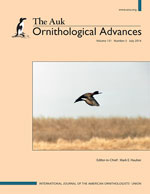Food availability is considered an important limiting factor in the breeding performance of marine birds, which exhibit restraint in reproductive life-history characteristics (e.g., delayed maturation, small clutch size, slow growth). Less well understood, however, is the extent to which taxonomic analogue species that breed in freshwater habitats are similarly regulated by food availability. Marsh-nesting Forster's Terns (Sterna forsteri) were studied from 2004 to 2008 at Horicon Marsh, a freshwater colony site in Wisconsin, USA, where reproductive success has been chronically poor. The adequacy of the food base to support a breeding colony of terns was evaluated (1) indirectly, through measures of breeding performance correlated with food availability during the egg-laying and incubation stages; and (2) directly, through a supplemental feeding experiment, conducted in 2004 and 2006, to determine whether nestling growth was limited by food availability. Clutch size, egg size, and adult body condition did not differ significantly among years, despite considerable annual fluctuation in environmental conditions and the rapid and extensive colonization of the wetland complex during the study period by a potential food competitor, American White Pelican (Pelecanus erythrorhynchos). Growth rates of chicks were ∼10% higher, on average, in 2006 than in 2004, but no difference was found in mean daily growth rates between food-supplemented and control chicks, nor did chick growth differ according to hatching order in the brood or hatching date. These results suggest that food availability is not a limiting factor during the breeding season for Forster's Terns at Horicon Marsh, the only actively managed breeding site remaining for this species in Wisconsin.
How to translate text using browser tools
2 July 2014
No evidence of food limitation during the breeding season of a freshwater marsh-nesting tern
David A. Shealer
ACCESS THE FULL ARTICLE

The Auk
Vol. 131 • No. 3
July 2014
Vol. 131 • No. 3
July 2014
breeding performance
chick growth
food availability
Forster's Tern
Sterna forsteri
supplemental feeding




